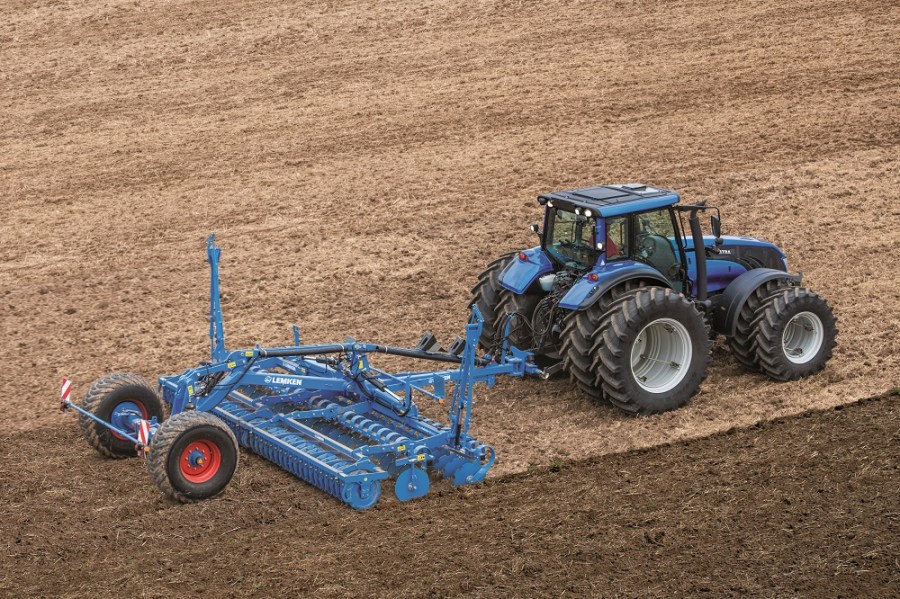Blackgrass control must be top priority
Advisers say growers facing an enormous rise in blackgrass populations must make the control of this pernicious weed the main priority as fieldwork begins. CPM looks at the latest techniques to help improve control.
The blackgrass situation in many parts of the country this year is beyond belief
By Mick Roberts
Growers, particularly those with medium to heavy soils, must consider controlling blackgrass as their top priority this season, says Dick Neale of Hutchinsons.
“The blackgrass situation in many parts of the country this year is beyond belief,” he continues. “Few frosts and the almost perfect growing conditions have seen infestations explode. It’s clear that in many cases, whatever control strategies that have been used in the past simply haven’t worked and the weed population is expanding rapidly.
“When you bear in mind each head can yield 100 seeds, growers will need to take unprecedented steps to ensure these are treated properly. This’ll mean looking at how to create stale seedbeds, the type of machinery used for establishment, delaying drilling as well as a move to spring cropping in the worst affected areas. Nothing can be left to chance and every option needs serious consideration,” he adds.
Stale seedbeds
Previous and current cultivation practices are, he believes, in many cases to blame for today’s levels of blackgrass. Stale seedbeds are often seen as a key first control but, he says, these are often not as effective as they could be. “Scratching the surface with a straw rake isn’t good enough, it simply doesn’t encourage enough of the seeds to

Compounding the already bad blackgrass problem is the appearance of very long seed heads this season. Typically, each will shed 100 seeds.
germinate. Conversely other machines cultivate too deeply.
“Blackgrass germinates in the top 50mm of soil. So that’s how deep the seedbed needs to be – not 75mm or 25mm – it needs to be exactly 50mm. But I’ve found many existing machines simply can’t maintain this exact depth or aren’t set and adjusted correctly,” he explains.
Many operators, he fears, don’t pay enough attention to detail to create the best quality stale seedbed. “A stale seedbed needs to be a proper seedbed. It has to create a tilth in which the seed will grow, with good consolidation to provide seed-to-soil contact as well as conserve moisture,” he explains.
Results of trials at Hutchinsons’ Brampton national blackgrass centre of excellence show this meticulous approach, using the right machine and settings, can deliver good control. Since 2012, cultivating the top 50mm has reduced the burden by 93%, from 760 plants/m² to 52 plants/m² in the untreated plots.
“The problem is those 52 plants/m² now have on average 15 tillers… And those will produce 75,000 seeds/m² in the untreated area,” he explains.
Dick Neale has been working closely with Cousins to produce the Surface shallow cultivator. Developed specifically for making stale seedbeds, it works in the top 50mm soil surface to create a good seedbed to promote weed-seed germination. It uses rigid tines, which remain at the set depth, unlike a spring tine, which will flex and work at varying depths. The seedbed is then consolidated by a ballasted roller that firms the soil around the seed and helps retain moisture.
Following a stale seedbed with a deeper cultivation from even a min-till type cultivator only compounds the problem, he adds. “All this does is bring up seeds from depth, while mixing others throughout the soil profile. This creates a cycle of burying some weed seeds, distributing them through the soil profile and then bringing them all up again the next year.
“Restricting all cultivations to the top 50mm will create an undisturbed ‘depletion zone’ deeper in the soil profile where blackgrass seed will decay at about 70%/year. So, in theory, the seed bank should be depleted entirely in five years, provided there are no deep cultivations.”
There’s a place for rotational ploughing, he says, but feels its use as a ‘reset’ is now not as effective as before. This is due mainly, he feels, to the continued churning of the soil by min-till techniques that have spread the seed throughout the soil profile.
“If you go really deep – say 275mm to 300mm – you might be able to turn 50mm of fresh, weed free soil on top of the mixed land. Of course it’s vital not to cultivate any deeper than that top 50mm otherwise you’re simply bringing up the same seed-bank,” he cautions.
Late drilling
For stale seedbeds to work, however, they must be used in combination with late drilling, he advises. “If you’re looking to control blackgrass you cannot drill wheat before 15 Oct. This is because there are two major flushes. The first occurs in the third week of Sept. Then there’s a second, major flush on or around 7-10 Oct. You can almost set your watch by it and there’s no point drilling before this date, otherwise the blackgrass will emerge in the crop, where it’s much harder to control.”
If conditions don’t allow you to drill at this time, then the only answer is a move to spring cropping, he adds.
Provided the correct type of drill is used there’s no need for further cultivations, he says. “Ask yourself whether you need to move soil. Cultivations are too expensive, unnecessary and, in many cases, are responsible for spreading blackgrass seeds through the soil to levels that are now out of control,” he comments.
Using the correct drill coulter – one that creates minimum disturbance – is imperative. While discs usually create the least disturbance, some tined drills will also fit the bill, but whatever the chosen type, it must be able to function in the conditions found later in the season.
“We recommend sowing wheat about 30mm deep. This is because we want to put on a stack of residual herbicides and virtually every label says the minimum sowing depth is 34mm,” says Dick Neale. “And, importantly, if you can’t
spray, you can’t drill. If the gap in the weather isn’t long enough to make that important application the only answer is, again, a move to spring cropping. You can use the extra time to continue to clean the seedbed ahead of a spring barley crop.
“Spring cropping is a good alternative and absolutely vital when trying to control blackgrass. It’s time to rethink the

Failing to control blackgrass has the potential to bankrupt some businesses, warns Dick Neale.
rotation – winter wheat should be kept to a minimum because you can’t control blackgrass in it. Spring crops are cheaper to grow, so produce a higher gross margin and clean the ground at the same time,” he says.
When faced with objections about the economics of spurning winter wheat in favour of spring barley, or dealing with wheelings when cultivating to just 50mm, Dick Neale’s response is blunt and clear: “These are insignificant difficulties compared with the real danger of failing to control blackgrass. It has the potential to bankrupt some businesses.”
Blackgrass control – Dick Neale’s top tips
- Weed control dictates rotation. Assess each field individually and seriously consider spring cropping to tackle grassweed infestations
- Cultivate stale seedbeds to no more than 50mm deep. Choose and set equipment carefully to ensure tines don’t bring seed to the surface
- Delay drilling. Leave bad blackgrass fields until after 15 Oct
- Place seed with care. Drill to at least 30mm depth and use minimum-disturbance discs or coulters
- Don’t drill what you can’t spray. If the weather’s closing in, shift to spring cropping.
Kit to curb the blackgrass burden
There’s now a wider range of equipment available to make shallow, stale seedbeds, with manufacturers responding to calls for machines designed specifically for the job. Claydon, for example, has introduced its new TerraStar, which uses special ‘star’ points to create a tilth to encourage weeds and volunteers to chit as well as to control slugs, but still leave the soil structure intact.
The shallow cultivation is achieved using ‘stars’, each with four knife blades, providing a total of 68 points. These are said to create 80mm square divots in the top layer of the soil in a 200mm grid pattern to a depth of about 30mm.
Väderstad has adapted its popular Carrier cultivator to make it more suitable for shallow tillage with a range of different disc shapes and size, including the new CrossCutter, which provides uniform, ultra-shallow (30mm) cultivations.
Mzuri takes the straw harrowing a step further on its Rezult with the addition of a set of leading discs to chop straw and trash and mix it into the surface. This works ahead of the machine’s five rows of 700mm tines, with hydraulically operated angle adjustment.
As its name suggests, the Dal-Bo MaxiRoll BlackGrass Harrow, is designed to create stale seedbeds. It uses four rows of 16mm diameter raking tines to create the tilth, and for chitting blackgrass the firm recommends the Cross-Combi packer ring option, in place of the standard Cambridge/Breaker rings.
The option of 510mm diameter discs with smaller notches on Kuhn’s Optimer disc cultivator makes it more suitable for shallower working. The cultivator employs two rows of discs, with adjustment for depth and cultivation intensity.
The He-Va Disc Roller’s two rows of discs and V-profile press are designed to shallow cultivate and consolidate at speed, providing a shallow stale seedbed for blackgrass control. The two rows of opposing discs are hydraulically adjustable from the tractor seat, allowing accurate depth control, says the manufacturer, and its Depth-Synchronised-Disc system automatically alters their vertical angle as their depth is changed.
Amazone’s Catros cultivator is available with smooth-rimmed discs which the company claims are suitable for the precise, extremely shallow and intensive mixing of stubble at working depths of 3-5 cm. This is followed by the wedge ring roller which levels the soil surface, while the reconsolidation is only carried out in strips, to get germination underway, but allowing water to infiltrate.
Lemken’s Rubin 12 is now available in a 7m version, with its two rows of large, 736mm diameter serrated concave discs. While it will work up to depths of 20cm, the machine can be set to work shallow by adjusting the self-levelling packer roller. Lemken recommends the W-profile roller to encourage blackgrass germination.
Establishment strategy makes big difference
Trials at Agrii’s Stow Longa blackgrass technology centre near Huntingdon, Cambs reveal the right establishment strategy alone can make all the difference to winter wheat performance even with the most challenging grassweed populations.
“The establishment work, run in conjunction with Lemken from 2010 to 2015, has shown how much growers can do to tackle the scourge of blackgrass without the need for major rotational change,” says Agrii’s Colin Lloyd.
Ploughing and delayed drilling stand out as the two key ingredients to emerge from the findings from the five different cultivation regimes and two sowing dates.
“Our study shows that a plough used tactically can make all the difference. What’s more, its effects can be very long-lasting. For instance, ploughing instead of min-tilling in 2010 with identical establishment practice in the following four years led the blackgrass population in our 2014/15 wheat crop to almost halve from 501 heads/m² to 266/m²,” he explains.
But the ploughing needs to be done properly, fully inverting the soil. It also does the most good where weed seeds have been concentrated near the surface following several years of shallow tillage. Ploughing again the next year, however, will undo all the work by bringing viable seed back to the surface.
Regardless of cultivation regime, some of the most consistently marked differences in both blackgrass control and crop performance at Stow Longa have come from delaying drilling by around a month – from late Sept to late Oct.
Drilling after the second week of Oct has delivered a yield advantage of more than 25% in every one of the four years of wheat in the rotation with an average annual increase of 41% for an extra income of over £360/ha/year.
This has come from levels of blackgrass control of about 90%, against little more than 60% for earlier drilling, because later drilling invariably enables far more weed seeds to germinate and be sprayed off ahead of sowing.
“Interestingly too, we’ve found later drilling can almost always do much to overcome problems created by inappropriate cultivation,” points out Colin Lloyd. “It has particular value where previous cultivation to different depths has left blackgrass seed well distributed throughout the soil profile, making any rotational ploughing a less effective solution.
“Deliberately delaying drilling on heavy land certainly takes planning and skill. But providing you have sufficient flexibility and capacity to employ the most appropriate varieties and equipment for the season we’ve found its value significantly outweighs its risk. This all the more valuable if you build in the option of delaying your drilling until the spring, should conditions get in the way of late autumn sowing,” he concludes.




